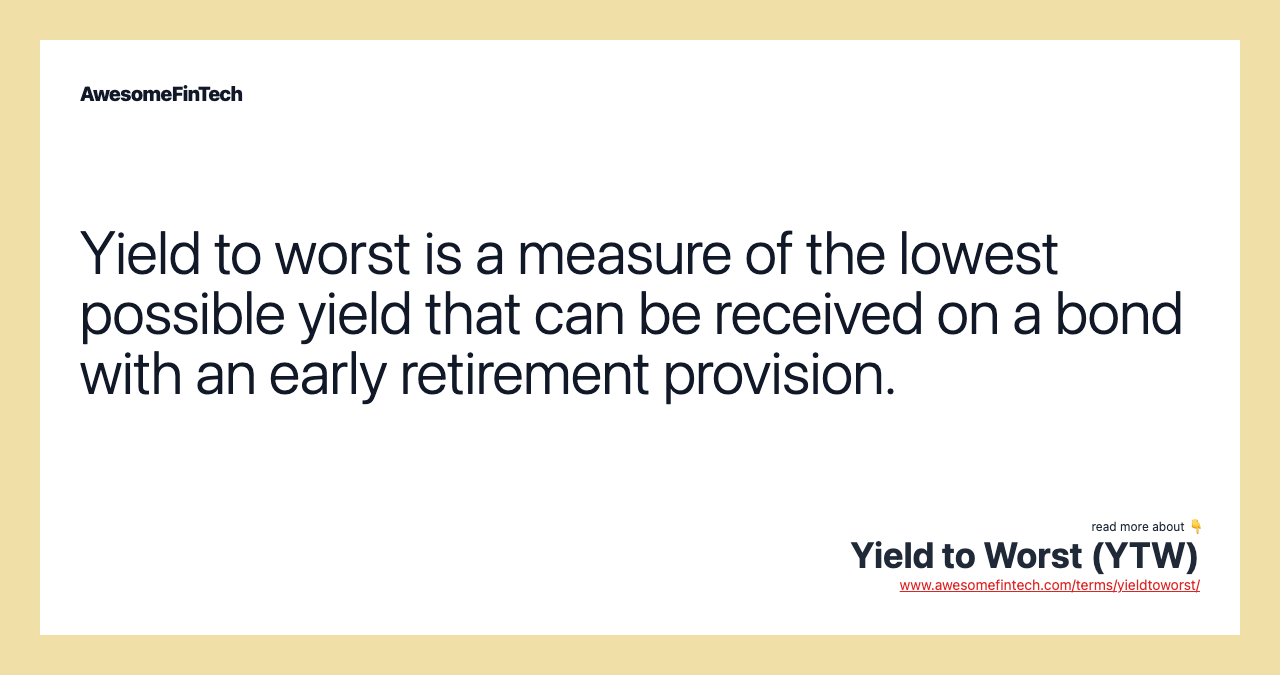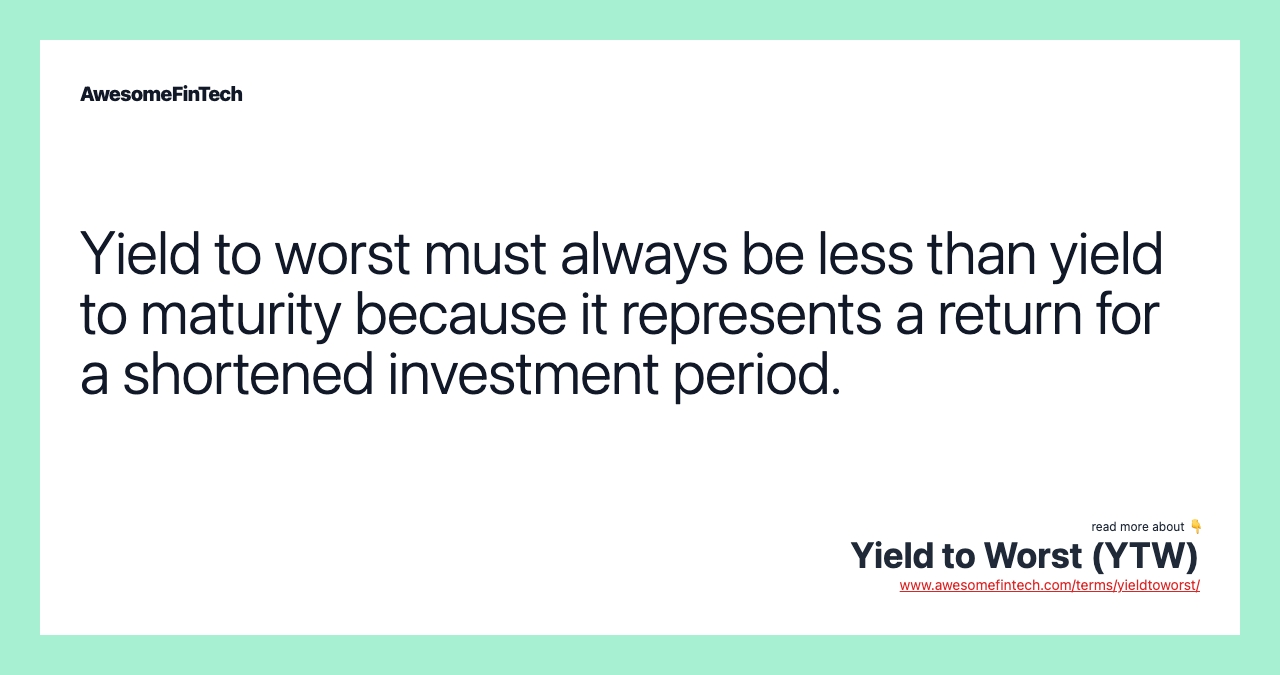Yield to Worst (YTW)
Yield to worst is a measure of the lowest possible yield that can be received on a bond that fully operates within the terms of its contract without defaulting. Early retirement of the bond could be forced through a few different provisions detailed in the bond’s contract — most commonly callability. The yield to worst metric is used to evaluate the worst-case scenario for yield at the earliest allowable retirement date. If a bond is not callable, the yield to maturity is the most important and appropriate yield for investors to use because there is no yield to call. In general, YTW may be the same as yield to maturity, but it can never be higher since it represents yield for the investor at an earlier prepayment date than the full maturity. The yield to maturity will always be higher than the YTW (YTC) because the investor earns more when they hold the bond for its full maturity.

What Is Yield to Worst (YTW)?
Yield to worst is a measure of the lowest possible yield that can be received on a bond that fully operates within the terms of its contract without defaulting. It is a type of yield that is referenced when a bond has provisions that would allow the issuer to close it out before it matures. Early retirement of the bond could be forced through a few different provisions detailed in the bond’s contract — most commonly callability.
The yield to worst metric is used to evaluate the worst-case scenario for yield at the earliest allowable retirement date. YTW helps investors manage risks and ensure that specific income requirements will still be met even in the worst scenarios.



Understanding Yield to Worst
A bond's YTW is calculated based on the earliest call or retirement date. It is assumed that a prepayment of principal occurs if a bond issuer uses the call option. After the call, principal is usually returned and coupon payments are stopped. An issuer will likely exercise their callable option if yields are falling and the issuer can obtain a lower coupon rate through new issuance in the current market environment.
The YTW may also be known as the yield to call (YTC). In order to identify the YTW, yield to call and yield to maturity should both be calculated. In general, YTW may be the same as yield to maturity, but it can never be higher since it represents yield for the investor at an earlier prepayment date than the full maturity. YTW is the lowest possible return an investor can achieve from holding a particular bond that fully operates within its contract without defaulting. YTW is not associated with defaults, which are different scenarios altogether.
The Mechanics
The yield to call is an annual rate of return assuming a bond is redeemed by the issuer at the earliest allowable callable date. A bond is callable if the issuer has the right to redeem it prior to the maturity date. YTW is the lower of the yield to call or yield to maturity. A put provision gives the investor the right to sell the bond back to the company at a certain price at a specified date. There is a yield to put, but this doesn't factor into the YTW because it is the investor's option on whether to sell the bond.
The equation for calculating YTC is the following:
Analyzing Yields
Yields are typically always reported in annual terms. If a bond is not callable, the yield to maturity is the most important and appropriate yield for investors to use because there is no yield to call.
Yield to maturity is calculated from the following equation:
Image by Sabrina Jiang © Investopedia 2020
If a bond is callable, it becomes important to look at the YTW. The yield to maturity will always be higher than the YTW (YTC) because the investor earns more when they hold the bond for its full maturity. The YTW is important though because it provides deeper due diligence on a bond with a call provision. The shorter time frame a bond is held for, the less the investor earns. YTW provides a clear calculation of this potential scenario showing the lowest yield possible.
Some other types of yield that an investor might also want to consider include: running yield and nominal yield.
Related terms:
Bond : Understanding What a Bond Is
A bond is a fixed income investment in which an investor loans money to an entity (corporate or governmental) that borrows the funds for a defined period of time at a fixed interest rate. read more
Callable Security
A callable security is a security with an embedded call provision that allows the issuer to repurchase or redeem the security by a specified date. read more
Callable Bond
A callable bond is a bond that can be redeemed (called in) by the issuer prior to its maturity. read more
Call Provision
A call provision is a provision on a bond or other fixed-income instrument that allows the issuer to repurchase and retire its bonds. read more
Coupon Rate
A coupon rate is the yield paid by a fixed income security, which is the annual coupon payments divided by the bond's face or par value. read more
Embedded Option
An embedded option is a component of a financial security that gives the issuer or the holder the right to take a specified action in the future. read more
Fixed Income & Examples
Fixed income refers to assets and securities that bear fixed cash flows for investors, such as fixed rate interest or dividends. read more
Put Provision
A put provision allows a bondholder to resell a bond back to the issuer at par after a specified period but prior to the bond's maturity date. read more
Reverse Convertible Bond (RCB)
A reverse convertible bond (RCB) is a bond that can be converted to cash, debt, or equity at the discretion of the issuer at a set date. read more
Spread-to-Worst
Spread-to-worst measures the dispersion of returns between the best and worst performing security and is often linked to bond markets. read more